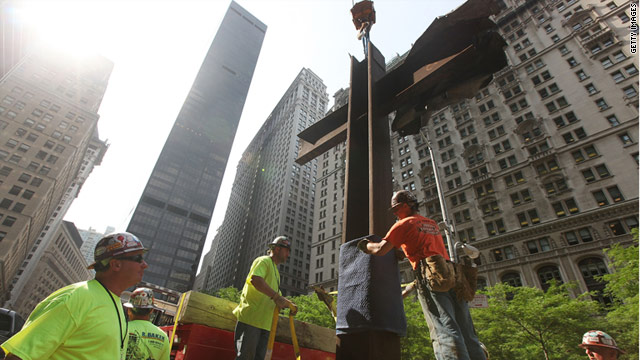
The Book of Revelation ends with a fascinating image: It is a a "new heaven and a new earth," reborn after the final judgement and the expulsion of sin.
"And I heard a loud voice from the throne, saying, "Now the dwelling of God is with men, and he will live with them. They will be his people, and God himself will be with them and be their God."
One of the actors in this final set piece, one of seven angels who had held seven bowls which poured out seven plagues in the destruction of the "first earth," emerges from the scene, takes the prophet to the top of a mountain, and gives him a preview of the coming kingdom--the New Jerusalem. And is what is striking about the New Jerusalem is this:
It's a cube.
The near wall is 1,400 miles long (the distance between my house in Tennessee and Gallup, New Mexico, going west). It is another 1,400 miles deep (I calculated this would take me to the middle of Hudson's Bay, Canada, traveling due north). It is also 1,400 miles high (about ten times further away than the International Space Station).
So the Bible ends with a giant, gleaming cube descending to planet Earth.
There's more to that cube that I'll cover later, but I'm fascinated by the fact that the New Jerusalem is a cube...until I consider the rest of the Bible, and realize that the whole story is cube after cube after cube--box after box after box--beginning with Genesis 1 and ending in Revelation 21.
Moreover, the cube ties in neatly with another important element of Biblical symbolism: the Number 7.
There is another cube in the Old Jerusalem, the city where Christ taught and died, and it was a copy of a cube constructed by Solomon in his temple. 2 Chronicles 3 states that Solomon laid out the Most Holy Place of that temple to be 30 feet X 30 feet X 30 feet, a perfect cube, separated from the temple's Holy Place by a curtain. (So important was the cube to Solomon's design, that a series of steps climbed from the high-ceilinged main room of the temple to the higher, cubic Most Holy Place.
Within the Temple cube was another box, the Ark of the Covenant (this was not a cube, but a box, about 2.25' X 2.25' X 4'). Within this box was the law of God.
Solomon's design dominated the Jewish imagination all the way to the time of John the Revelator--and not just Judaism, either. The fire-worshipping Zoroastrians incorporated the cubic room into their temples. (Pictured, right, is the Kaba-ye Zartosht, "The Cube of Zoroaster" in Persepolis, Iran, which has origins in the time of Persian King Darius I in the 5th Century BC.)
The Arabic word for cube, "Kaaba," echoes the name of the most sacred site in the religion of Islam: the curtained black cube in the Masjid al-Haram Mosque in Mecca toward which every Muslim directs prayers. (This cube is larger than Solomon's holy room, roughly 40' X 40' X 40'.)
I will describe more about this second cube later as we make our way backwards to Genesis,. Needless to say, Muslims are very aware of Biblical symbolism (moreso than western Christians), and provide an insight into the deep importance that the cube plays with God.
Of course Solomon didn't invent the cube. He based his design for the temple on that of the tabernacle revealed to Moses from Mount Sinai. The tabernacle (also known as the Tent of Meeting) also had a cube-shaped room, 15' X 15' X 15', exactly half the scale of Solomon's room. At the center of this room was also a box, the same box as the one Solomon placed in his Holy of Holies. Within this box were a few artifacts besides the Ten Commandments: a budding rod (a symbol of Aaron's power) and a bowl of manna were missing when the box's contents were chronicled in Solomon's day (1 Kings 8.9).
Creation, the Cube, and the number Seven
Islamic mythology traces the cube back to Adam, who built a cubic worship space in the lands westward of Eden to the specifications of God himself. Future prophets Noah and Abraham would return to Mecca, the site of the Kaaba, to rebuild the shrine (it is important to note here that the current Kaaba dates back to the early 10th Century).
Indeed the creation story can be seen as the building of a cube. Creation is divided into six days--the six sides of a cube. Imagine the creation story as the sides of a cube. There is a square of light at the bottom. The four sides are (1) land and water, (2) sky & vegetation, (3) sun, moon, and stars, and (4) birds & fishes. The top square of this box is the creation of beasts and humans on the sixth day.
When you see the creation story in the form of this cube, I think it grows stronger as a story--and explains some of the scientific contradictions that arise in more literal readings of Genesis 1. The foundation of the cube is light--as John 1 affirms--and its top is mankind. The middle four days are the walls, leaving the fact that Genesis shows plants on the earth a full day before there is a sun to sustain them, as a description of space, not linear time.
One could rewrite Genesis 1 along the lines of Revelation 21 this way: In the beginning, the Cube of Creation descended into chaos This is how the first heaven and first earth were made.
We have known about the linear week, and I know that I have practiced it all my life. But there is a cubic week in Genesis 1: a complete, six-sided box in which everything is complete.
Imagine creation as a cube. Turn it around in your mind and look at its individual sides. See the light, the water, the sky, the fishes, all moving in concert. It is beautiful, isn't it? It's amazing.
It isn't yet perfect.
Genesis 2 begins with the
seventh side of the box.
"By the seventh day God had finished the work he had been doing; so on the seventh day he rested from all his work. And God blessed the seventh day and made it holy because on it he rested from all the work of creating that he had done" (verses 2-3).
In terms of the box, God needed a seventh side. That seventh side was holiness, and I believe that he put it
in the middle of the box--a.k.a. the seventh side. No one waits until the seventh day of the linear week to rest; no, we sprinkle rest throughout the week--it touches all six sides. Nor was holiness intended--I believe--to be a linear idea but a spatial one.
Look back through the Biblical cubes I mentioned. The cubes--the Holy of Holies in the tabernacle and the temple--have boxes in them. And in these boxes is the Law of God. These cubes are filled with holiness.
As always, the prophet Isaiah describes the Seven-Sided Cube far better than I could ever do:
"This is what God the Lord says--
he who created the heavens and stretched them out,
who spread out the earth and all that comes out of it,
who gives breath to its people,
and life to those who walk on it;
'I, the Lord, have called you in righteousness...." (Isaiah 42.5-6)
Here we have the sides of the box (heavens, earth) and the box's top--the "breath of its people and life to those who walk on it." But there is also righteousness, holiness, the seventh side that touches upon all others. It isn't just attached to the "man" side of the cube, it touches
all sides of the creation.
The New Jerusalem and Me
There is another number in the Bible that has a symbolism quite opposite to the number 7. Revelation states that "it is man's number. His number is 666" (13.18). If the number 7 represents a created cube filled with holiness, it's pretty easy to interpret 666. It means "empty, empty, empty."
I want to close with the first cube--the massive New Jerusalem--because now that I understand the seven-sided box, I want to know this:
What's inside the big cube?
There is no temple in this New Jerusalem (I have written about this wrinkle in a
previous blog). This is
"because the Lord God Almighty and the Lamb are its temple. The city does not need the sun or the moon to shine on it, for the glory of God gives it light, and the Lamb is its lamp" (21.22b-24).
That's the inside of the box--the seventh side--and it touches on all six sides: the jewel-encrusted foundations, the four golden walls, and the crystal ceiling that glows with the light of the Creator.
There is so much to learn from this paradigm, but I want to close this blog and get your feedback. Here are some questions I hope to answer in the future:
- Did Jesus understand the seven-sided cube? What are some of his teachings that can be understood spatially?
- There are many references to empty boxes in the Bible--a desire to place God's law in the empty hearts of mankind. Can these be better understood by the seven-sided box?
- What are some other cubes mentioned in the Bible? I almost added Noah's Ark to this discussion, but it wasn't a cube--although it was a box. Another nominee might be Joseph's casket as it was carried to Caanan.
 Fine Just the Way it Is by Annie Proulx
Fine Just the Way it Is by Annie Proulx





